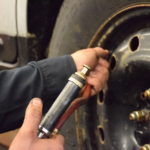 An engine is a complicated thing that works on a fairly simple principle: the explosion of a flammable substance– namely gasoline. The exploding takes place in the combustion chamber as fuel is sprayed into the cylinder, and then ignited by a tiny spark. It’s a highly regulated process which takes place many times per second, every single second your engine is running.
An engine is a complicated thing that works on a fairly simple principle: the explosion of a flammable substance– namely gasoline. The exploding takes place in the combustion chamber as fuel is sprayed into the cylinder, and then ignited by a tiny spark. It’s a highly regulated process which takes place many times per second, every single second your engine is running.
It’s the job of the lowly spark-plug to set the fuel and air mixture up into flames at a very precise moment. It happens when an electrical current is sent between the electrode and ground of the plug, arcing between the two. The resulting spark only exists for a fraction of a second- but it’s all that’s needed to get the job done.
Precision is the name of the game when it comes to efficient internal combustion. If your ignition system is worn out or working poorly, this precision becomes compromised- and so does your engine’s power, fuel mileage and smoothness. A problem with the ignition system can have a lot of symptoms you may feel, from a simple reduction in performance to a nasty stumble or even a no-start situation.
Many newer vehicles have ignition systems that are virtually maintenance-free for the first 160,000 kilometres or so. If you have a vehicle like this, your ignition system maintenance is virtually non-existent. If that’s not the case, you’ll need some fairly basic regular maintenance to keep things igniting at their finest.
If your car, truck or SUV is an older model, it’s probably equipped with a cap, rotor and plug wires which send the electrical current required for ignition to the plugs themselves. Over time, as with any part, these components will wear out and need to be replaced.
A cap and rotor, for instance, have a finite life-span. When they start to wear, poor performance can be expected. Additionally, the spark-plug wires will dry out and crack after prolonged exposure to the harsh environment under the hood. When the rubber covering on the wires cracks, the current flowing through them may escape to a nearby metal part. This will reduce or even prevent the current from actually making it to the plug. It’s just one example of an ignition system problem.
Your owner’s manual or dealership has information on the recommended service intervals for your particular vehicle’s system. Roger Lariault, a Hyundai service centre foreman, explains “when spark plugs are replaced, the technician should check the ignition wires and ignition coils or cap and rotor- depending which your vehicle is equipped with’.
Having a spark-plug change and ignition system inspection on your average four-cylinder car won’t take very long- though prices and labor increase for larger 6 or 8 cylinder engines. Lariault says that pricing ranges from about $60 to over $100, depending on the model in question.
If you don’t know when your vehicle’s ignition system was last maintained, it’s probably due for some attention. Not only will you experience increased power and smoothness, you’ll also likely burn through less fuel and spit less pollution into the atmosphere as well. Perform ignition system maintenance alongside a fuel injector cleaning service for maximum results.
Your engine will probably feel good as new!





